Fermented Cherry Tomatoes
Making fermented cherry tomatoes requires a wild heirloom culturing process, which differs from wild fermentation. Sometimes, vine-growing vegetables, like cherry tomatoes, contain higher amounts of fermentable sugars. They are called cherry tomatoes because they are sweet and small.
This method employs using sauerkraut brine and apple cider vinegar to ferment fresh vegetables, using wild bacteria found in sauerkraut brine. You can use any extra fermented vegetable brine you have, like pickle brine or fermented pepper brine.
This method of fermentation is quite similar to yogurt fermentation, but here we are culturing vegetables with natural sauerkraut brine and ACV instead of using industrially manufactured starter cultures. This method is somewhat similar to refrigerator pickling but with microbes.
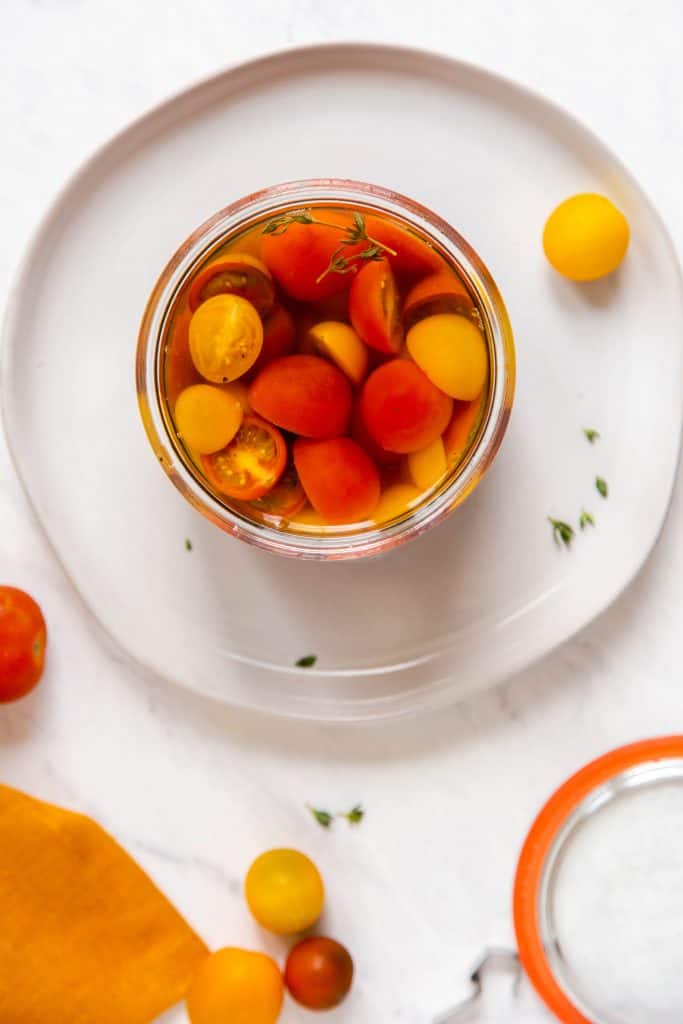
Lacto Fermented Tomatoes
So can you ferment tomatoes? If you’d like to stick to a true wild fermentation method for fermenting cherry tomatoes, be my guest. But I do not suggest it. Cherry tomatoes are more like fruit, they contain a good bit of fructose, so they are more prone to alcohol fermentation. I know a lot of people love to experiment though, and I always encourage it. Just use a 4% total salt concentration and see what happens. Through my own experience and through microbiological testing of my results, I cannot guarantee that traditional wild fermentation of cherry tomatoes is the healthiest option.
To read more about salt concentrations in fermented vegetables you can reference our Complete Guide to Safely Using Salt in Vegetable Fermentation.
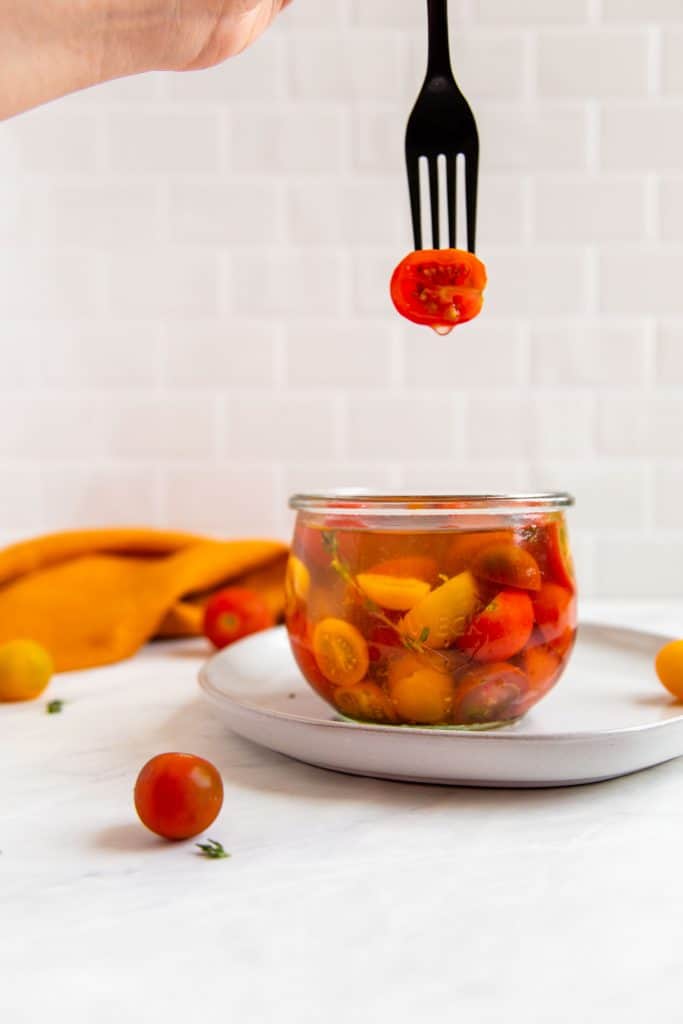
Fermented Tomatoes
You are welcome to test out other types of tomatoes with this recipe. We also have a How to Ferment Green Tomatoes recipe blog you should try! For this recipe, you will need some naturally fermented sauerkraut brine (or any fermented vegetable brine), apple cider vinegar, and a bit of salt. We, of course, utilized some of our leftover sauerkraut brine and regular unrefined sea salt for this recipe. If you’ve fermented pickles or sauerkraut at home, either brine will work great!
Fermented Cherry Tomatoes
This is a different kind of vegetable fermentation: You are culturing the tomatoes using sauerkraut brine, so you only need to ferment them for 24 hours, then place them in the fridge.
Always Trust your sense of smell: Fermented tomatoes should smell pleasantly sour and similar to a brined olive. Never eat anything that smells repulsive.
Never eat anything that had mold growing on it: By following the recipe you should not encounter this problem.
Taste test at 24 hours: If you prefer the tomatoes to be more tart and sour, let them sit in the refrigerator for a few days before eating. After 24 hours they should taste similar to brined olives.
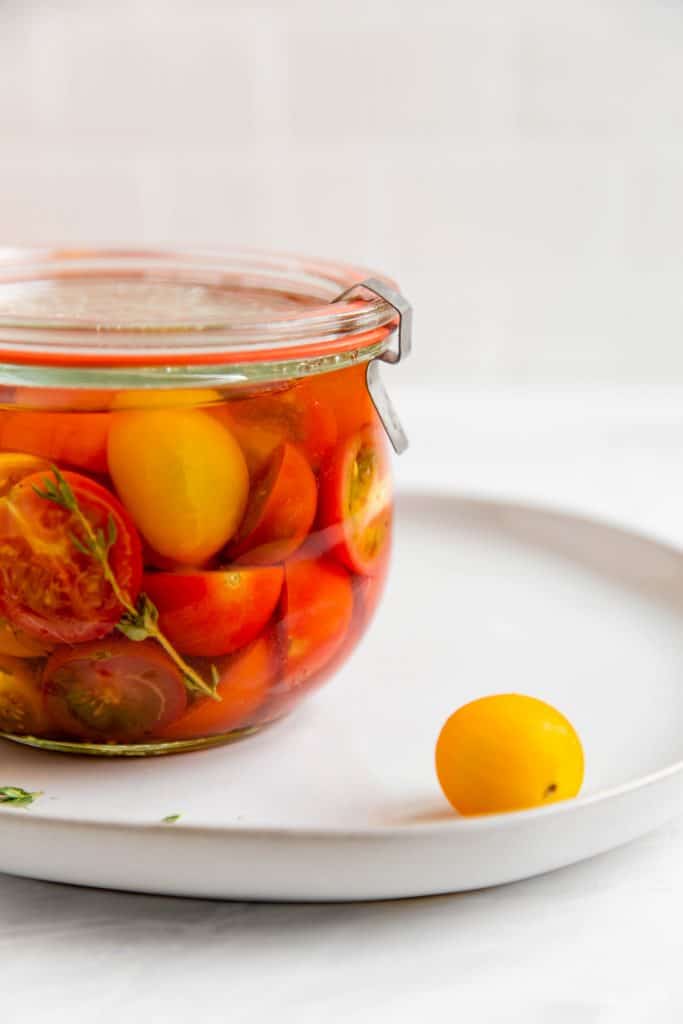
Probiotic Pickled Cherry Tomatoes
This recipe for making fermented cherry tomato pickles is very easy, but there are some things you will need to remember:
- Keep your fermenting tomatoes at a temperature between 70-80 degrees F for 24 hours.
- Keep out of direct sunlight
- Since this is a fermentation with added cultures from the fermented vegetable brine, you should only ferment the Tomatoes at room temperature for 24 hours max. Then place the tomatoes in the refrigerator.
- Consume within 6 months for full probiotic benefits!
Supplies You Need to Make Fermented Cherry Tomatoes
- 16 oz Wide Mouth Mason Jar
- Fermentation Weight to fit your mason jar
- Standard Metal Mason Jar Lid (this can rust in the presence of salt)
- OR Rust Free Plastic Lid
- Unrefined Sea Salt
- Scale
- Mixing Bowl
- or you can use a Weck Jar (which is what is pictured here)
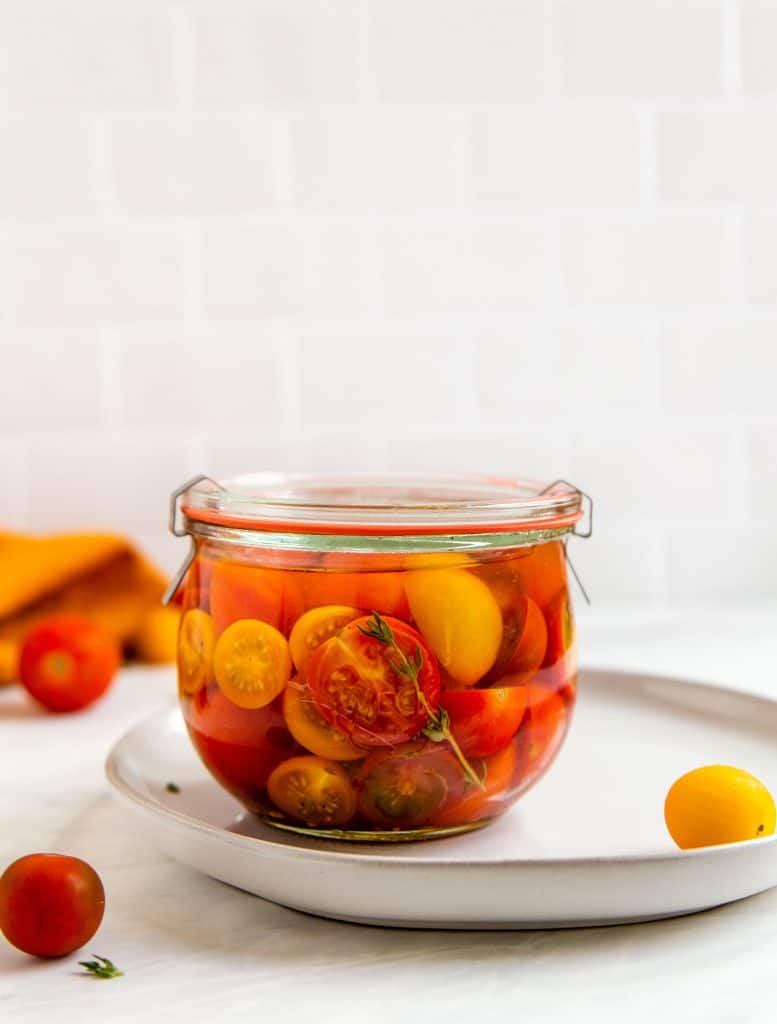
How to Make Fermented Cherry Tomatoes
This recipe makes the most flavorful, healthy fermented cherry tomatoes. In just 24 hours, you’ll have absolutely delicious probiotic pickled cherry tomatoes!
- Prep: 15 minutes
- Total Time: 15 minutes
Ingredients
- 200 Grams Cherry Tomatoes, sliced
- 5 Grams of Unrefined Sea Salt
- 175 Grams of Fermented Sauerkraut Brine
- 75 Grams of Raw Apple Cider Vinegar
Instructions
- Wash your fermentation equipment (jar, weight and lid). I like to sterilize my jars by pouring a little vodka in them, and shaking it around, then emptying it and letting it air dry.
- Wash your cherry tomatoes in cool water.
- Place your kitchen scale on the counter. Turn it on and set it to weigh in grams.
- Place a mixing bowl on your kitchen scale and tare/zero the scale.*
- Add tomatoes into the bowl on your scale until the scale reads 200 grams.
- Remove the bowl from your scale.
- Place your empty, clean mason jar on the scale, and tare/zero the scale. Make sure your scale is still set to grams and add 175 grams of sauerkraut brine (or any fermented vegetable brine) and 75 grams of apple cider vinegar to the jar.
- Add the 200 grams of tomatoes, into the mason jar.
- Place a small bowl on your scale and tare/zero the scale. weigh out 5 grams of salt. Then add the 5 grams of salt to the jar.
- Place your standard mason jar lid on the jar, and secure. shake the jar vigorously for 2 minutes. (if you do not have a fermentation weight, simply stop here and place the jar in the fridge! Otherwise, move on to step 11)
- Remove the silver standard mason jar lid. Place your fermentation weight in the jar making sure to submerge the tomatoes and weight fully in the liquid.
- Secure the lid on your jar
- Ferment for 24 hours.
- Then remove the weight, secure a lid to the jar, and store in the fridge.
Notes
Once you eat all the tomatoes, use the brine for salad dressing! It’s delicious.





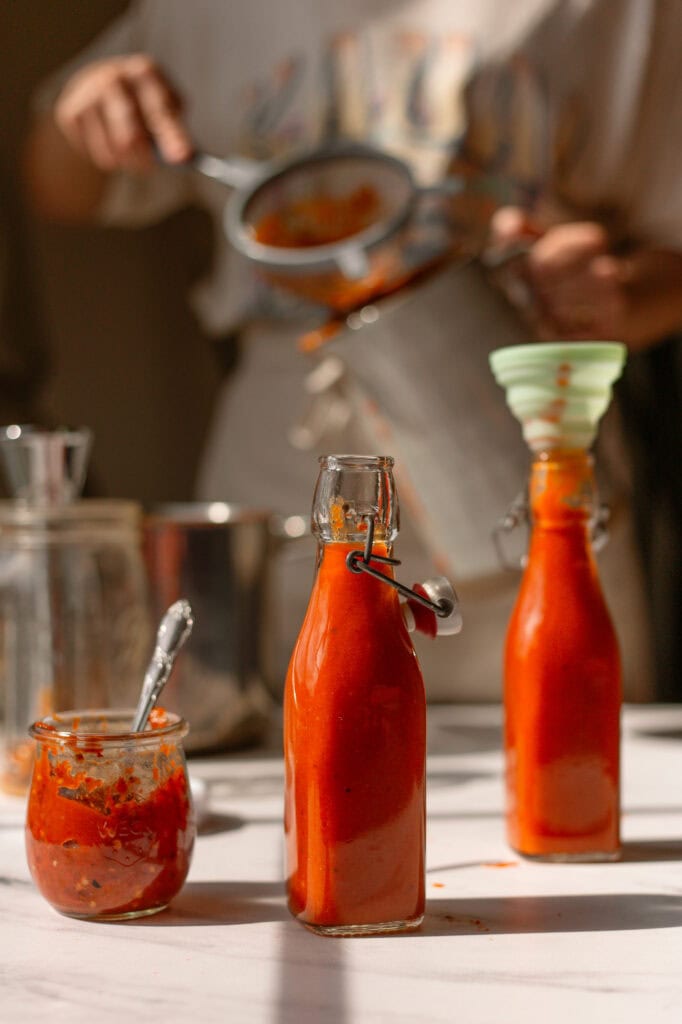





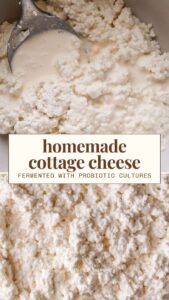

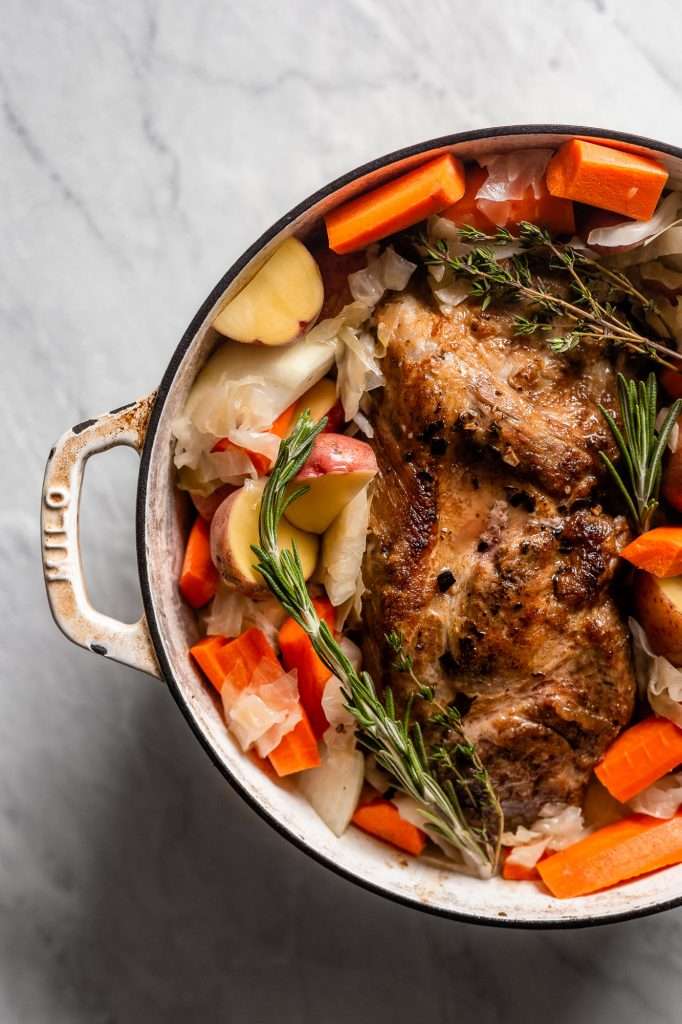
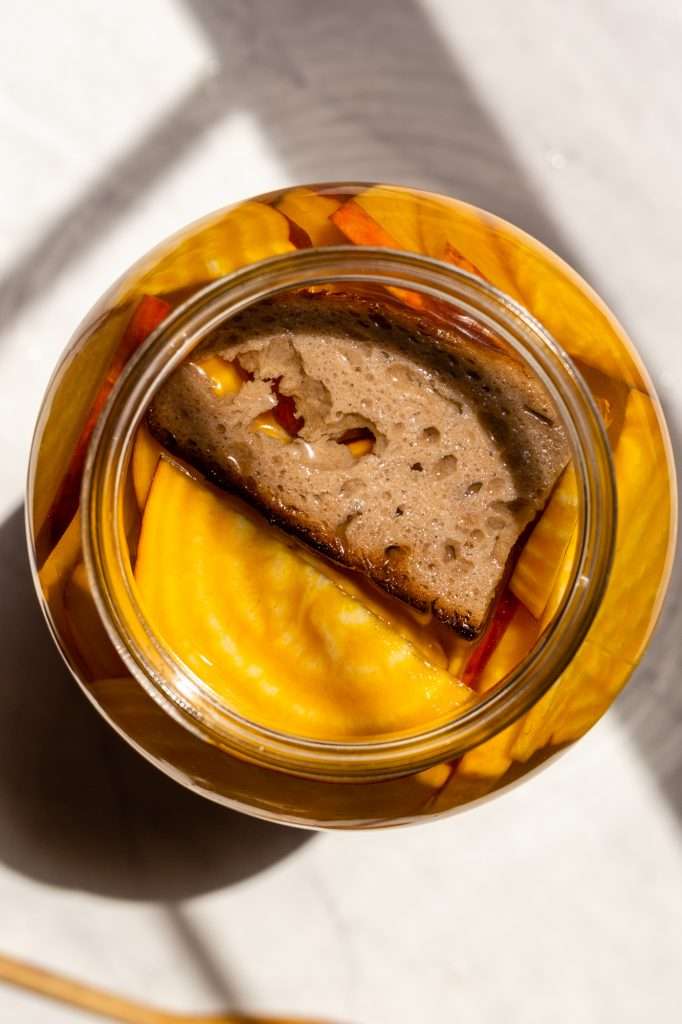
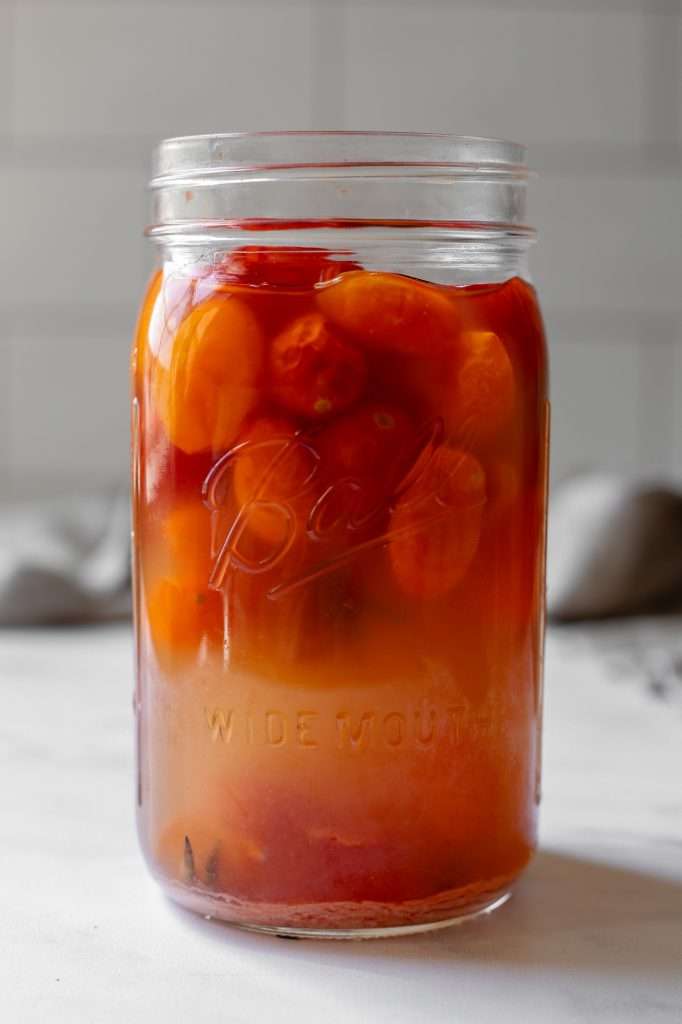
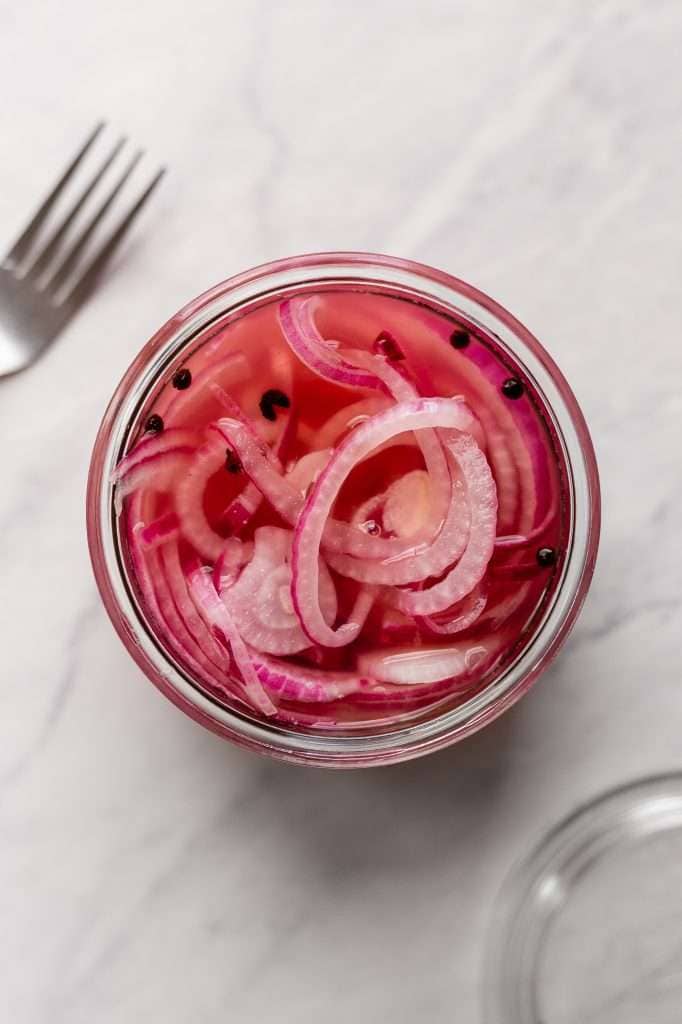



I’m an absolute beginner here and I’ve got a handful of homegrown cherry tomatoes and little cayenne peppers along with the notion that I’d like to ferment them in a jar together. I read that I need sauerkraut brine to follow this recipe and that takes a month! Can you suggest a recipe for my precious tiny harvest that I can begin now?
This is the only way I ferment cherry tomatoes. You can also slice the tomatoes and add them to our sauerkraut recipe. They ferment so well when combined with cabbage.
If you want to try someone else’s recipe, you can check out a blog called “Grow Forage Cook Ferment” I think she has a recipe for cherry tomatoes using just salt and water. They will be yeasty and effervescent for the reasons I explained in my post, but feel free to try it.
Thanks, Kaitlynn, I’ll nab some cabbage and put them in. Should I include the cayenne peppers, too? That would be pretty tasty… I’m not to sure about effervescent tomatoes!
Does it have to be brine from sauerkraut? Would another brine work?
Sauerkraut brine works best, but you can try other fermented vegetable brine. Depending on the quality of the fermented vegetable brine you are using, you may have different results with this recipe.
Do you add extra salt to the brine to keep the concentration right since you are adding vinegar and thus diluting the sourkraut brine? Or is the addition of salt something to do with the fermentation process? Thanks
Making these tonight! My 16 ounce jar (which is actually an old cultured guru kimchi jar) doesn’t fit my fermentation weight. All the tomatoes are under the brine. Is this okay as long as the brine is covering them?
Tried this reicipe and its amazing. After all tomatoes vere eaten we used leftover brine to drop in other vegitables (and kept them in fridge overnight) – they too tasted great next day 🙂
I’m so glad you enjoyed the recipe! I use the leftover brine to make more tomatoes too 🙂
Hey! I have a question regarding the use of vinegar in ferments. 1/3 of the brine in your tomato (both green tomatoes and red cherry) recipes is apple cider vinegar. I have always thought that you cannot ferment with vinegar as you are creating a rather different environment (introducing acetic acid bacteria in to the mix and I assumed they will inhibit the proliferation of lactic acid bacteria?). Could you elaborate on this a bit? Since you are an expert 🙂 I have found little information on this topic. Thank you in advance!
Yes, that’s correct. I call this method wild heirloom culturing. This is more similar to culturing yogurt than it is to wild fermentation. While vinegar fermentation and vegetable lacto-fermentation are two completely different processes, the byproducts (brine and vinegar) can be combined to “pickle” vegetables with live active cultures.
Acetic acid bacteria and lactic acid bacteria can reside in the same mixture. Some bacteria, Leuconostoc species, in wild fermented vegetables produce lactic acid AND acetic acid. They do not inhibit one another, and acetic acid does not kill Lactobacillus species. There are also Lactobacillus species naturally present in all raw apple cider vinegars.
If you look at sourdough starters, for instance, starters naturally always contain yeast, acetic acid bacteria, and lactic acid bacteria. They can all live in one environment.
Acetic acid bacteria do require oxygen to thrive though, while Lactic acid bacteria thrive in anaerobic conditions. So in a recipe like this, the acetic acid bacteria are more dormant, and the lactic acid bacteria are more active.
I love your idea for heirloom fermentation. I used this recipe for salsa (tomatoes, onion and cilantro). Instead of sourkraut brine, I used brine from Carolina reaper peppers I’d fermented last fall. Turned out amazing!!!
oh wow! that sounds amazing.
Great recipe!
Would they keep fermenting if we leave them out longer than 24h? I have TONS of cherry tomatoes and loads of brine from fermented cucumbers- I would like to keep them for winter – so actually out of the fridge as there is no space left really for this quantity;D Could this work?
Of course once opened- they would move into smaller jars and fridge.
Thanks a lot!